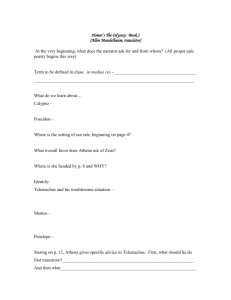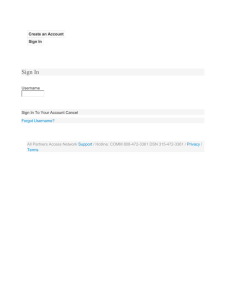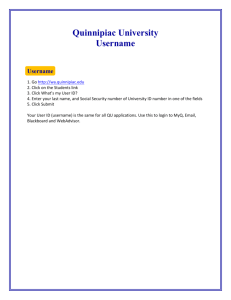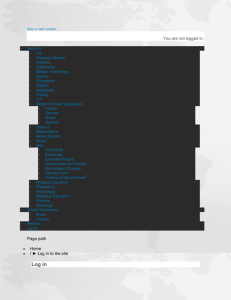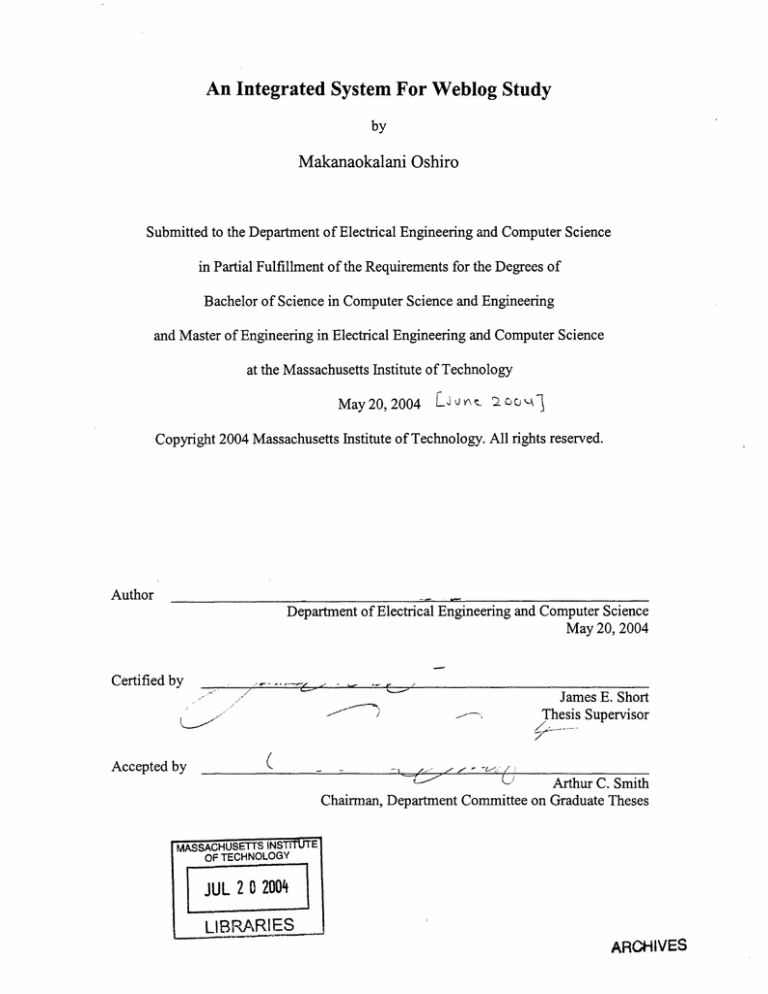
An Integrated System For Weblog Study
by
Makanaokalani Oshiro
Submitted to the Department of Electrical Engineering and Computer Science
in Partial Fulfillment of the Requirements for the Degrees of
Bachelor of Science in Computer Science and Engineering
and Master of Engineering in Electrical Engineering and Computer Science
at the Massachusetts Institute of Technology
Lgh 2o,.']
May20,2004
Copyright 2004 Massachusetts Institute of Technology. All rights reserved.
Author
Department of Electrical Engineering and Computer Science
May 20, 2004
Certified by
-
-' --
·
J
I, . .
Accepted by
I--
(
--
James E. Short
Thesis Supervisor
f...
~.SCT~.~
-,
- -
Arthur C. Smith
'
Chairman, Department Committee on Graduate Theses
INSITUT
MASSAHUSETS
MASSACHUSETTS INSTi=lE:
OF TECHNOLOGY
JUL 2 0 2004
LIBRARIES
ARCHIVES
An Integrated System For Weblog Study
by
Makanaokalani Oshiro
Submitted to the
Department of Electrical Engineering and Computer Science
May 20, 2004
in Partial Fulfillment of the Requirements for the Degrees of
Bachelor of Science in Computer Science and Engineering
and Master of Engineering in Electrical Engineering and Computer Science
ABSTRACT
Weblogs, personal online journals, are a new medium for expression and communication.
Studies to determine their effectiveness of information transmission are interesting, but
difficult to perform without access to underlying data. We propose an independent
weblog server that records all relevant data and a procedure to analyze the content and
access patterns. This complete system is useful for weblog research.
Thesis Supervisor: James E. Short
Title: Visiting Scientist, Center for eBusiness at MIT
2
__I__
I
·I
_I
__
_
I·I
I
Acknowledgements
I would first like to thank Nortel Networks, the Center for eBusiness, and MIT Sloan
School for helping sponsor my thesis research. Without their assistance, I would not have
been able to pursue my research at all, much less complete this thesis. Particular thanks
go to Deborah Stokes and Todd Etchinson at Nortel for getting excited about weblog
research and putting us in touch with Project Acumen. They opened my eyes to uses for
weblogs that I had not expected or considered.
I would also like to thank my thesis advisor James Short. I have worked with Jim
for two years, and he has consistently served as my research guide. His knowledge and
input have added greatly to the content analysis portions of my thesis.
Finally, I would like to thank my parents and sister, who have supported me
through this odyssey that is MIT. When each trial or challenge appeared, they were there
to keep me going forward.
3
Contents
INTRODUCTION.............................................................................................................
5
WEBLOGS ..........................................
TEXTUAL CONTENT ANALYSIS .......................................................................................
ADVANTAGES OF A COMPLETE SERVER ..........................................................................
5
7
7
DESIGN CONSIDERATIONS
AND ASSUMPTIONS ...............................................
8
PROTOTYPE SYSTEM SPECIFICATIONS .............................................................. 9
SUPPORT SYSTEM SOFTWARE ..................................................................
10
WEBLOG SOFTWARE..........................................
10
ANALYSIS SOFTWARE ..........................................
11
DEMONSTRATION OF USE ..........................................
REGISTRATION..........................................
TYPICAL POST................................................................................................................
REMOTE ADMINISTRATION ..........................................
ANALYSIS ......................................................................................................................
CONCLUSIONS AND FUTURE WORK..........................................
DIFFICULTIES .................................................................................................................
FUTURE WORK ...............................................................................................................
11
11
12
13
13
13
14
14
CITATIONS .................................................................................................................... 17
APPENDICES ................................................................................................................. 18
PROSPECTIVEUSER EMAIL ..........................................
REGISTRATION SCRIPTS ..........................................
INSTALLATION INSTRUCTIONS ..........................................
LIVEJOURNAL ON WINDOWS ..........................................
4
I·I_·_
~~~~~~~~~_·_·
~~~~____~~~~~~~~~~~~_~~~~~
___
____
_______~~~~~~~~~~~~~~~~~~~~~~~~~~~~~~~~~~~----
18
18
21
22
Introduction
The expansion of the Internet has allowed the development of an increasingly online
society. In addition to downloading information from conventional sources, the
submission of content by ordinary individuals has sharply increased in the past few years.
Personal web pages have been available for several years, but they are mostly static and
rarely updated. Web forums, where large numbers of users contribute to discussions,
have become popular, but the principal method of individual rapid content generation is
the weblog.
"Web logs" are best described as personal online journals. In a reversal of the
privacy of a conventional journal, the weblog is available to the Internet at large. Users
typically post mundane details of their everyday lives, highly opinionated "rants" about
current topics, or hypertext links to interesting material. The indirect references and direct
links form a network of information connectivity in the format of the World Wide Web,
but with a drastically increased formation rate. Weblogs are a goldmine for researching
online communication and discourse.
Weblogs
The burgeoning popularity of weblogs can be traced to tools that allow users to post
content frequently and easily. Without these tools, users were forced to format and date
additional content by hand, whereas these mundane tasks are completely automated now,
making them accessible to users who would not have taken the time and effort. Another
cause for the expanding weblog user base is the availability of mobile weblogs, or
5
"moblogs," weblogs primarily updated from a mobile device such as a PDA or camera
phone. With a camera phone, a user can snap a picture, add a short caption, and upload it
directly to their moblog. Standard blogs can be made to support these features as well,
but moblogs are characterized by shorter posts and an emphasis on media.
Weblogs can also be categorized by their hosting. There are major sites (Xanga,
TextAmerica) that provide free hosting and for-pay extended services for the weblog
user. These can be differentiated by the size of the site, the number of users, and the
amount of daily traffic. Site structure is fairly standard among the large sites, with each
weblog having a list of "friends" and "blog-rings" (groups) on its front page. Submission
can be done through email or the web interface. The site front pages generally have
selections of interesting posts, images, and entire weblogs and links to help pages. There
are also a number of free software packages (LiveJournal, Movable Type) that a
technically savvy user can run on his own web hosting. Specialized submission software,
such as KABLOG for cellular phones, works only on individually hosted weblogs.
The weblog form factor can be applied to uses besides personal journals. The
format can just as easily cover a project log, accessible to the group members, who can
post comments about each status update. A feedback mechanism can be built in as well,
so that test user comments are distinguished from developers, but still clearly in reference
to a new particular revision. Although robust against drifting off-topic, the weblog
comment format does not allow comments to be easily made in response to other
comments.
Other researchers are studying weblogs for a number of features. One is Cameron
Marlow at the MIT Media Lab, who is researching information propagation between
6
__·
__II·1____1______________
weblogs with his blogdex site, itself a weblog. Many of these groups run a weblog to
report on their project progress.
Textual Content Analysis
Our group has previously done analysis of disclosure data. We saved thousands of
articles in text format, ran them through a parser, and fed them to General Inquirer, a
dictionary-based content analysis tool. With it, we can generate a weight matrix
measuring different features that can be analyzed statistically. The copy of General
Inquirer was modified to support batch processing of many small files. An aggregation
program for combining General Inquirer results for a large number of small files was also
written.
The same approach should work on weblog content. The weblog posts are
exported to text, and then processed into properly formatted text for the parser. The
parser screens the text for keywords that are supplied in its dictionary. The comparative
changes in General Inquirer weights between unparsed and parsed sets can be used to
measure the effectiveness of the keywords.
Advantages of a Complete Server
Unmodified textual content analysis can be run on text data only, without a context. It
would be possible, given permission, to download all the data posted on a popular weblog
site and run an analysis. The site structure would be maintained and posting dates are
typically displayed below each post, but the data of access patterns would not be
downloaded. The context surrounding a user's post, such what they were reading
immediately prior or how many edits were used, would be unavailable.
7
A server under complete control of the research group would have none of the
disadvantages of the downloading method, and would have complete knowledge of a
number of interesting features. In particular, web server specific data, such as clickthrough and referrer data can be logged, tracking where users come from and where they
go. By creating indirect links to offsite sites, users can be tracked as they go offsite.
Correspondence can also be drawn between readers and writers. We can see a user read
another user's weblog, go to a referenced site, and then write his own post.
Design Considerations and Assumptions
The first consideration of the proposed server is that it must run the Windows operating
system. All of our text analysis is also run on the machine, so it must be user-friendly to
anyone who needs to process or retrieve any data. An OS that users are typically familiar
with makes it easier to perform basic tasks. However, there is a tradeoff, as open-source
software does not tend to immediately run on Windows. The system is being run headless
in a server room, with limited physical access, so it must run reliably with zero local
access except in exigent circumstances. Since text-only support is lacking, we need solid
remote GUI access, TightVNC, to properly control the Windows system.
At the same time that we allowing access, we must make sure that the system is
not vulnerable to compromise. All legitimate administrative functions (TightVNC remote
control and file transfer) are done through secure ssh tunnels provided by Cygwin. A
software firewall, typically ZoneAlarm, limits world-access to the intended web server
only.
The web server itself needs scripting support and a backend database to support
8
__
__1·__I__
__I___
___I·^__
the weblog. EasyPHP bundles together an Apache web server, a MySQL database, and
PHP scripting support in a package pre-configured to work together.
The choice of weblog software package has a number of limiting requirements.
The selected system must run reliably on Windows, must be extensible, should support
weblog standards, and will hopefully be popular and in common use. A number of the
available packages, such as LiveJournal, do not run on Windows. As LiveJournal fits all
the other requirements well, this was quite disappointing. The ability to add our
enhancements through a plugin system is a key requirement. Compatibility with weblog
interface specifications allows greater flexibility in submission options, as the user is free
to use third-party software without problems. A popular system will be more likely to be
familiar to users that used it previously, and would be likely to be easy to learn for new
users. Movable Type satisfies all of the requirements.
The analysis software used includes a basic parser to select "paragraphs" based on
a dictionary. The text exported from the weblog content database must be formatted to
meet the parser's input specifications, but has no restrictions otherwise.
Prototype System Specifications
Our server is a Dell workstation pressed into service as a server. It runs an Intel Xeon
processor 2.40GHz with 1GB of physical RAM, plenty for a server with a limited number
of users. The operating system is Microsoft Windows XP Professional Version 2002,
SP1. ZoneLabs ZoneAlarm is configured as a loose firewall shield, allowing all of MIT
to access available services (web server and ssh port), but disallowing IP addresses
outside of MIT.
9
Support System Software
Cygwin provides basic sshd services that allow a client to connect securely with ssh and
then send data through the established secure tunnel. Both TightVNC and file transfer are
conducted through these secure channels. The administrator must login using a standard
ssh client supporting tunneling, then run the desired program to use. Putty is a free ssh
client that also provides a scp (secure copy) program for file transfers. The ssh
connections can be compressed, allowing better performance in addition to security.
Cygwin can also be used as a limited text-only shell if VNC fails, and can restart the
computer remotely with the shutdown command if absolutely necessary.
A TightVNC server program is run on the server on the VNC default port 5900,
and the client is run on the administrator's local machine. The server program is run as a
Windows service, so that it starts automatically on boot and is always available. The
preferred settings are optimized for speed by enabling image compression and color
reduction.
Weblog Software
The web server is the EasyPHP 1.7 bundle of Apache, MySQL, PHP, PHPmyadmin, and
other utilities. It comes configured with working defaults. The support scripts, including
registration, are written in PHP. Movable Type requires Perl to run, so ActiveState Perl
for Windows was used. Movable Type is installed with all the required and optional Perl
modules for maximum functionality.
On the web server, the registration scripts, the Movable Type installation, and the
published blogs are each stored in their own directory within the web-accessible
10
-.-.--..--- ·--.i---·
_·
___
directory. The directories help with site organization and with individualized file
permissions. To protect data, a number of permissions were customized, including
making include files non-readable and cgi files execute-only, preventing unauthorized
access to source code.
Within the Movable Type installation, the first user is named Administrator and
given complete access to all weblogs. Each new weblog is initialized with both the new
user and the Administrator as owners. The user cannot remove the Administrator as a coowner, and some features are hidden from the users, such as local file paths and user
renaming.
Analysis Software
The basic parser was written from scratch in Java. It requires specific text formatting to
break up paragraphs. If a word from the dictionary is present in a given paragraph, the
paragraph is kept in the output file; if no words are present, the paragraph is removed.
General Inquirer requires no special formatting.
Demonstration of Use
Registration
To register, a user goes to http://disclosure.mit.edu/register.html. Accessing the site
requires an MIT IP address, and successful registration requires an MIT Athena
username. The user submits their Athena usemame and a desired weblog username. This
flexibility allows non-matching usernames to preserve privacy if desired. The script
(source code included in Appendix) checks if the Athena username is well-formed, if
11
either username has been already registered, and finally verifies the Athena username
with People Search from the MIT homepage. If all succeeds, a confirmation email is sent
to the user's Athena email address and a temporary record is saved. A confirmation email
is common web practice for verifying that a given user has proper access to the account
in question.
The email contains a short description of its purpose and a confirmation link with
a randomly generated key. When the user enters the link, the system verifies that the
registration details and key match an existing temporary record. Once confirmed, the new
user's information is saved in the permanent registration database, their weblog is
generated, and the temporary record is purged. The user is forwarded to a "registration
successful" page with a link to their new weblog.
It is also possible for the administrator to add usernames if necessary, using a
private script that ignores the verification steps. The username should not match Athena
username, but there is no restriction. Privacy must be maintained if the data ever leaves
the study group, so the registration database is kept separate from the weblog data
structure. If the data is ever provided to an outside party, either only the analyzed
conclusion data will be provided, or the registration database will be used to excise
personal information from the weblog contents.
TypicalPost
The user logs in via the Movable Type login page, which sends him to a listing of his
weblog. Movable Type allows for multiple weblogs per user, but the standard structure of
our implementation limits this to one. He selects his weblog and then new post from the
sidebar. The user enters a title and post content, and then publishes the post. After a quick
12
-------
1_~1_1~
_
generation process, the weblog is updated and can be previewed.
The discerning user has a choice of saving the post as a draft for finishing later or
publishing immediately, as well as an option to have a summary of the post on the front
page with a link to a complete copy. There is also the option of submitting posts from a
third-party application, such as KABLOG, or emailing it to a special submission address.
Remote Administration
The administrator ssh's to the server using with Putty with tunneling enabled on port
5900. The client vncviewer program is run, which pops up a window of the server's
screen. The administrator is now remote controlling the server from his computer.
Most of the administrative tasks of interest can be accessed from the EasyPHP
system tray icon. There are entries for changing configuration settings, restarting the
server processes, or opening PHPmyadmin for MySQL or other maintenance. The web
server logs can be read in plain text in the apache directory.
Analysis
A weblog's content is analyzed through the following process: the MySQL database
entry is exported to text, formatted for the parser, parsed, and then run through General
Inquirer, resulting in a output weight matrix. The Apache web server logs are imported
into MySQL, where they can be easily arranged by IP address, date, or other access
feature.
Conclusions and future work
The server and analysis tools, as constructed, form a complete toolkit for our approach to
13
weblog research. Further research can be easily done using this project as a "turnkey"
solution and a stepping-stone.
Difficulties
We experienced pronounced difficulties with generating data from our preliminary user
set. The attempted trial period, one week of heavy, forced activity was far too short. A
month-long trial would have yielded more data, but our feeling is that it may be too short
as well. Our limited set of users was also too small, but the underlying problem is
assembling more than a few related users. Either the overall number of users is too low or
the expected yield per user is reduced due to the users not knowing each other well.
Weblog content seems to be event driven, that is, an interesting event yields interesting
weblog post. A potential approach would be to study a student group for the month
before a major event, but preparations could have the reverse effect of decreasing
postings.
Purely volunteer weblog users do not generate enough content on their own. An
incentive structure of some sort may increase useful postings or may attract users more
likely to post. A weblog site must provide a compelling reason to be used, such as being
large or better than its alternatives.
Future work
Adding security and user attribution to the server would be an interesting improvement
that is quite easily implemented. A server certificate can be requested from MIT to certify
the server, allowing it to conduct secure https connections. The functionality is already
present in the default configuration of EasyPHP, so it is just a matter of enabling it for the
14
___
11111_-·-----
proper sections. Secure login and post submission, or even a completely secure weblog
site, are all applications. Additionally, secure web-based administrator access, which was
previously too insecure, could be enabled as another fallback option.
Requiring users to login for read access would allow tighter tracking of users.
While some tracking can be implied using IP addresses, logging in to read as well as to
post is a powerful tool. The cookies that Movable Type uses to track submission logins
can be reused for this application. A limited "preview" mode could be made available so
that potential users can read weblogs, but a disincentive should be added to prevent users
from using this exclusively and invalidating the new login.
Click-through tracking for offsite links is another source of tracking information.
Whenever a user reads a page on our server, the access is logged, but no information is
recorded if they follow a link to another site. However, if the offsite link is replaced with
a local page that then forwards the user, this access is recorded. This layer is easily
implemented with a database holding the local/offsite link relationships and is in common
use on many sites. Click-through can also check the effectiveness of advertising, either in
the form of banner ads or inline advertisements.
Movable Type does not natively support the feature of user groups. Adding the
groups or "blogrings" structures would allow group formation to be studied. There are
implicit groups created if users consistently link to each other, but these structures make
the relationship explicit. If users can create their own groups, the formation patterns are
clear as new members join.
It may be possible to replace the Movable Type weblog system with LiveJournal,
which has a better design than Movable Type for this application, but does not run on
15
Windows. Movable Type is intended for a small number of weblogs (up to 15 in common
usage) with each user assumed to be a system administrator. LiveJournal supports large
amounts of users and has appropriate security measures. The principal difficulty with
installing LiveJournal is that there are a number of dependencies on Perl modules that are
simply not implemented in Windows. It is possible to edit the header files to remove the
dependencies and force LiveJournal to install, but operation is unreliable. Compiling the
required modules for Windows would be a sizeable task, but would have good returns.
16
· ____II_
___
______
Citations
[1] ActiveState- ActiveStateActivePerlfree Perl open sourcebinary language
distribution. http://www.activestate.com/Products/ActivePerl/?_x=1.
[2] blogdex - the weblog diffusion index. http://blogdex.net.
[3] Camera Phone Moblog Community I Textamerica.com.
http://www.textamerica.com/.
[4] Cygwin Information and Installation. http://www.cygwin.com.
[5] [EasyPHP] - Apache IMySQL I PHP I PhpMyAdmin.
http://www.easyphp.org/index.php3?lang=en.
[6] ImageMagick - Convert, Edit, and Compose Images. http://www.imagemagick.org.
[7] Inquirer Home Page. (General Inquirer) http://www.wjh.harvard.edu/-inquirer/.
[8] KABLOG. http://www.rawthought.com/projects/kablog/.
[9] LiveJournal.com. http://www.livejournal.com.
[10] Movable Type Publishing Platform. http://www.movabletype.org.
[11] Seb 's Open Research. http://radio.weblogs.com/0110772/2003/10/16.html#al 172.
[12] Xanga.com. http://www.xanga.com/Default.aspx?.
[13] Zone Labs: Zone Labs, Internet security products, online safety, software,
protection. http://www.zonelabs.com/store/content/homej sp.
17
Appendices
Prospective User Email
Subject: Registering to use a weblog
From: Kalani Oshiro <koshiro@MIT.EDU>
The registration page is here:
http://disclosure.mit.edu/register.html
"Blog name" is your desired username on the blog server. For this trial,
it can match your Athena username if you like. Your blog's overall name
can be changed later as desired (it is initialized to your username).
For example, my Athena username is koshiro, my blog username is kalani,
and my blog's name is "Kalani's Blog".
You should receive a confirmation email to your MIT address with a
link.
The blog management page is here:
http://disclosure.mit.edu/movabletype/mt.cgi
The blogs are stored here:
http://disclosure.mit.edu/blogs/blogusername
Two things are required to use the system automatically:
MIT email address (username) - evident by "Invalid Athena Username"
error while registering; I can add users manually if necessary
MIT (18.*) IP address - evident by "connection refused"; other static
addresses can be allowed
Thanks for your help,
Kalani
Registration Scripts
register.html
<html>
<head>
<title>Initial Registration Screen</title>
</head>
<body>
<h3>PHP User Registration</h3>
<form method="post" action="register.php">
<table>
<tr><td>Athena username:</td><td><input type="text" name="athena" size="8" maxlength="8"
/></td></tr>
<tr><td>Blog name:</td><td><input type="text" name="blog" size="25" maxlength="25"
/></td></tr>
18
____
</table>
<input type="submit" value="Register" />
</form>
</body>
</html>
register.php
<?php
// register.php
// Registers new users
// User Fields: $athena, $blog
//
$athena = Athena username
//
$blog
= Desired blog username
include 'reg-globals.inc';
// accept POST submission only, no GET
$athena = $_POST['athena'];
$blog = $_POST['blog'];
if (($athena == '') || ($blog == ''))
// fields left blank
$error = 'Please complete both username fields.';
include $ERROR_PAGE;
exit;
}
if (strlen($athena) > 8)
// Athena username is too long
$error = 'Athena username more than 8 characters, invalid.';
include $ERROR_PAGE;
exit;
if (strlen($blog) > 25)
// Blog username is too long
$error = 'Chosen blog username more than 25 characters. Please choose a shorter one.';
include $ERROR_PAGE;
exit;
}
$athena = strtolower($athena);
$blog = strtolower($blog);
if (ereg("[^\-_\.0-9a-z]", $athena))
// Athena username contains invalid characters
$error = 'Athena username contains invalid characters.';
include $ERROR_PAGE;
exit;
if (ereg("[^\-_\.0-9a-z]", $blog))
// Blog username contains invalid characters
$error = 'Chosen blog username contains invalid characters. Please choose another
one.';
include $ERROR_PAGE;
exit;
}
$encodedAthena = urlencode($athena);
$fingerpage = fopen ("http://web.mit.edu/bin/cgicso?query=username%3D{$encodedAthena}",
r") ;
if (!$fingerpage)
$error = 'Unable to load Athena finger page.';
include $ERROR_PAGE;
exit;
19
while (!feof ($fingerpage))
$1line= fgets ($fingerpage, 1024);
if (ereg("
email: <A HREF=\"mailto:(.*)\"", $1line, $out)) {
$email = $out[1];
break;
fclose($fingerpage);
if ($email == '') {
$error = 'Athena username not found.';
include $ERROR_PAGE;
exit;
}
$db_conn = mysql_pconnect ("localhost", $DB_USER, $DB_PASS);
mysql_select_db($DB_NAME_REG);
$mq = mysql_query("SELECT athena "
" FROM 'queue'" .
"WHERE 'athena = '{$athena}'");
if (mysql_num_rows($mq) != 0) {
$error = 'Athena username present in queue pending confirmation.';
include $ERROR_PAGE;
exit;
}
$mq = mysql_query("SELECT id "
" FROM 'registered'"
"WHERE 'athena = '{$athena}'");
if (mysql_num_rows($mq)
!= 0)
{
$error = 'Athena username present in registered users.';
include $ERROR_PAGE;
exit;
}
$mq = mysql_query("SELECT athena "
" FROM 'queue'"
" WHERE 'blog' = '{$blog)'");
if (mysqlnum_rows($mq) != 0) {
$error = 'Blog username present in queue pending confirmation.';
include $ERROR_PAGE;
exit;
$mq = mysql_query("SELECT id "
" FROM 'registered"
" WHERE 'blog' = 'I$blog}'");
if (mysql_num_rows($mq) != 0) {
$error = 'Blog username present in registered users.';
include $ERROR_PAGE;
exit;
}
// alphanumeric
function randomstring($len) {
while($i<$1len)
{
$select = rand(0,2);
switch($select)
case 0:
// numbers
$str .= chr(rand(48,57));
break;
case 1:
// uppercase letters
$str .= chr(rand(65,90));
break;
case 2:
// lowercase letters
20
$str .= chr(rand(97,122));
$i++;
return $str;
$key = randomstring(25);
$mq = mysql_query("INSERT INTO queue ( 'athena' , 'blog' , 'key' )
"VALUES ( '$athena' , '$blog' , '$key' );");
mysql_close();
// send email
$content = "Thank you for registering.\n\n"
"Please go to the URL below to confirm your registration.\n\n"
"http://{$_SERVER['SERVER_NAME'] }/confirm.php?athena=($athena}&blog=($blog}&key=($key}";
mail ($email,
'Blog Registration Confirmation',
$content);
// please check your email to confirm
include('register-success.inc');
?>
InstallationInstructions
Installing programs
Install Cygwin, the only additional package is sshd. Once the package is installed, set
sshd to run as a Windows Service. When sshd is first run, it will ask to build a password
file from the Windows Users database. Allow this to copy usemames and passwords to
its file. Otherwise, sshd will not be aware of any users or their passwords will be
initialized to random characters, and login will not be allowed.
Install TightVNC and set to run as service. The server will be enabled on port
5900, the VNC default.
Install EasyPHP. Set the language to English. Set to run as service if the site is
meant to be up all the time, but this is optional. If it is not set as a service, it must be
manually started after boot. Set correct hostname and contact information in httpd.conf.
21
Install ActiveState Perl. It is best to install to \Perl, because all the Perl scripts in
Movable Type must be edited to point to this path.
Install Movable Type, following the provided installation manual. Make sure to
edit each of the Perl scripts to point to the correct Perl path. Install the required Perl
packages using ppm in the Perl directory. ImageMagick is an optional but useful module.
Copy script files into standard web directory, generally EasyPHP/www.
Installation complete.
Possible problems
Be sure to verify that you can access the server remotely before removing local access.
The easiest way is to ssh out and back in. If ZoneAlarm is misconfigured, the connection
will be refused. If the connection is accepted, but the username or password is invalid, it
is an sshd configuration problem.
When tunneling VNC with Putty, make a local tunnel from L5900 to
127.0.0.1:5900. The remote address is relative to the remote host, so 127.0.0.1 specifies
the server itself.
LiveJournal on Windows
LiveJournal server code is readily available (http://www.livejournal.com/code/), as well
as documentation for installing and running on Unix-like systems. However, there are
missing Perl modules on Windows that need to be either dereferenced or compiled.
ppm automatically downloads and installs Perl modules if they are available in
binary format. CPAN has access to both binary and source distributions, but needs to be
configured with a compiler.
22
_111
1__
Unicode::MapUTF8 is the module that prevents LiveJournal from installing, but
there are other, optional, modules with problems. The suggested workaround is to edit
MapUTF8.pm to remove the reference to Unicode::Map8. In theory, there are two
conflicting implementations of this function, so removing one does not cause any
problems. LiveJournal was completely installed, but would not load properly after this
fix.
23

